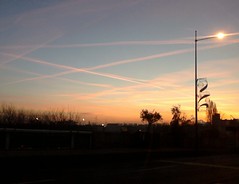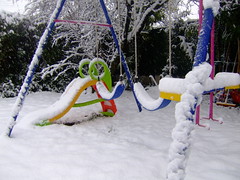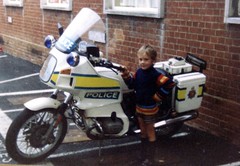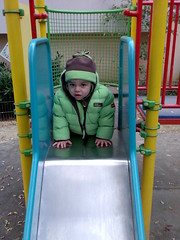Just what is it that makes Flickr stand out from other sites, so that it can boast an impressive 2,000+ photos uploaded per minute? That’s 2,880,000 a day, and over a billion – or a thousand million for those who think a billion is a million million – per year!
Their tour covers some of the ground, but it doesn’t touch on some of the things that make Flickr different. Most sites offer ways to upload, share, organise and classify (tag) your photos. Fewer have discussion groups, pools of photos sharing a common interest, and comment systems. Some integrate very well with digital printing of photos, so that you can order your photos to be delivered in a variety of formats and on objects too. But Flickr is more that that. It has an exceptionally intuitive interface and has built a sense of community around the concept of interestingness.
The interface makes it easy to upload photos, with large clear links to point you through the three step process: “Choose Photos”, “Upload Photos” and “Add titles, descriptions, tags or add to a set”. Perhaps they should have just called the last step “Describe Photos”, but then you can also add them to a set at the same time (tough call, I’d opt for keeping it simple). Once your photos are uploaded, you have them all displayed in front of you – unless of course you uploaded a large amount at once – and can add titles and descriptions in a very simple way. A click in the zone where a photo is to be described, or in the title zone (usually filled with the photo filename already) allows you immediately to change or add the text you want. You don’t have to reload the page. The information already there looks like normal text on the screen. But when you click it, it becomes editable in a text box, and then you click “Save” or “Cancel” and it goes back to being normal text.
This feature makes it easier to keep track of whether you are actually editing something since text that has been edited, or is yet to be treated, will not be in a text box, and will hence be completely visible. Also, text boxes have to be limited in width in order to display well, but normal text will wrap as you expect it to rather than disappearing. This also prevents errors in your typing as you see all the text at once on photos you’ve saved descriptions and titles for.
Another interface which is worth seeing is the map, which allows you to place your photo at the geographical point at which it was taken. It’s basically Yahoo! maps embedded into Flickr, with your photos listed along the bottom. You search for the town where the photos were taken, zoom and scroll around, and then just drag and drop your photos to the right place. A click on a link on the map page will allow you to see all other photos taken in the region of the map you’re looking at. This sounds very Web2.0, but in fact it is the former text editing feature which I think, for its simplicity, takes the crown. “Click to edit” relies on DHTML and AJAX – making changes to a web page without reloading it is the DHTML part, and AJAX is used to load the information back to the server when you click “Save” without making the whole page reload. The technical terms don’t matter much, the fact is that many sites could do this, but don’t. It’s complicated to start with, but it makes perfect sense to use this kind of technology — as long as it makes things easier.
Interestingness is the algorithm that allows Flickr to select photos from the millions uploaded each day while trying – as much as is possible with mathematical logic – to make them represent the very best of the site. It works surprisingly well. Behind that link, the photo was selected by a machine, but I bet you it’s a nice photo.
Web communities often have a sense of competition between members, and on Flickr the kudos awarded to photographers who make the “Explore” pages is a driving force for many. Even if you don’t care too much about public glory (who doesn’t?) you can click a link, visible only to you, to see your photos ranked by interestingness. This can lead you to start asking good questions about your shots and why they might be interesting for others. The magic formula behind the ranking is a combination of many things. One thing that makes it work well, even if it is a machine that is doing the calculations, is the volume of human input that can be used to come up with values to plug into the equation. How many people clicked on a photo (Flickr is full of places where you can see random selections or related photos); what the person was looking at before they clicked; whether they commented, and keywords in that comment (superlatives tend to abound in great photo’s comments); how many times the photo has been viewed; how many people consider the photo a favourite; the words and tags used to describe the photo itself; the resolution of the photo and the camera used to take it… there may be many more factors that Flickr might not want to reveal to avoid the tinfoil hat brigade’s wrath.
Flickr fully respects my idea of Web2.0 – which is all about interactivity both with the site itself, and with other users in the community. It’s about user interface design and bringing exciting new functionality to web sites.
Flickr drives the community via classic interfaces such as the forum, comments on individual photos, and email notification of changes and updates. These are all really well integrated with photography at the heart of everything. Finding interesting images can be done via groups, by searching, by surfing around the “explore” section and importantly just by logging in – a selection of “Everyone’s Photos” appears on your homepage.
Your sense of being in your own community is added to by your “Contacts”, who have their section on your homepage “Photos from your Contacts”. Adding a few people whose work you appreciate – or friends you want to share fun pictures with – quickly tailors the site so it feels like it belongs to you, even though you don’t feel like you’re personalising it at all.
In fact, personalisation is probably even more at the heart of Web2.0 than anything else. If the tailoring of a site to your tastes and desires happens without you even realising it, then it’s sure to become a place you visit often. Perhaps that is why Flickr is such a fine example of how engaging websites can be, and why it represents Web2.0 so well.






